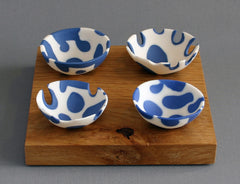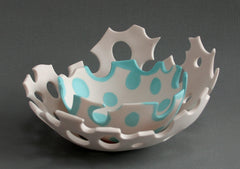Meet The Studio Potter : Vivienne Saunders 22nd Mar 2016
How did you first get interested in ceramics?
It started when I worked for the NHS Occupational Therapy (OT) department as an OT Assistant and I had provided support for clients during pottery sessions. When the Pottery Technician decided to leave, I was asked, and then interviewed by the Head of the OT department to take on the role temporarily until the post could be filled. I had a week with the Pottery Technician, before she left, to learn Health and Safety, basic studio management, kiln firing etc. It was quite a learning curve, as they say, but I really enjoyed it and ceramics has now become an important part of my life. The department expanded and my role as a Pottery Technician became permanent. During this time I had a 1½ day release over 2 years at The Oval Annex at Stafford Art College and obtained a City and Guilds Part 1 & Part 2 in Ceramics.
before she left, to learn Health and Safety, basic studio management, kiln firing etc. It was quite a learning curve, as they say, but I really enjoyed it and ceramics has now become an important part of my life. The department expanded and my role as a Pottery Technician became permanent. During this time I had a 1½ day release over 2 years at The Oval Annex at Stafford Art College and obtained a City and Guilds Part 1 & Part 2 in Ceramics.
How many years now have you been working with ceramics?
About 25 years. When I retired, however, I was able to concentrate fully on my own work but I wanted to further extend my knowledge so I applied to Wolverhampton University to study for a BA (Hons) degree in Design and Applied Art (Ceramics). After gaining a First Class Degree I joined the Midlands Potters Association which gave me the support and opportunities to apply for exhibitions such as this hosted by the Barewall Gallery at Middleport Pottery, the venue for the exciting BBC’s, “The Great Pottery Throw Down”.
What clay, materials and techniques do you use?
I’ve used many techniques in my past work but my current ceramics are handmade with a combination of Valentine’s Parian clay and Parian casting slips. All my work is decorative and quite small. I use water erosion and some of my bowl rims are  carved. I use Wet & Dry paper or a Diapad to smooth the surface after the first firing. I then fire at 1220 degC with a 20minute soak to bring out colour and translucency – the colour and designs run throughout the clay body. I also use a slip trailing technique to form some of my cradle bases and I make all my own plaster moulds. I use stains from Sneyd Ceramics and oxides from Potclays all in varied percentages.
carved. I use Wet & Dry paper or a Diapad to smooth the surface after the first firing. I then fire at 1220 degC with a 20minute soak to bring out colour and translucency – the colour and designs run throughout the clay body. I also use a slip trailing technique to form some of my cradle bases and I make all my own plaster moulds. I use stains from Sneyd Ceramics and oxides from Potclays all in varied percentages.
Where do your designs come from?
The natural world. It has a never-ending supply of inspiration and complexity. My current work is focused on nature at the microscopic level with its beautiful patterns and textures that are unseen to the naked eye.
What is Parian Ware?
Because of its similarity in looks to that of marble, the Victorian middle classes were attracted to it because it enabled them to afford high class ornaments which would otherwise be out of their reach. It was derived from French white porcelain biscuit figures. The biscuit was quite cold to look at and companies wanted a warmer, creamier medium that could be cast into attractive forms. Wedgwood called it “Carrara”, but it was Minton who named it Parian after the Greek Isle, Paros that provided much of the stone during the Classical period.
Vivienne Saunders 22nd March 2016
During Meet The Potter event forming part of the activities during
Barewall Presents The Midland Potters Association at Middleport Pottery
15 Potters over 5 Weeks
Sat 19th March 2016 to Sun 24th April 2016
EXHIBITION . DEMONSTRATIONS . MEET THE POTTER
